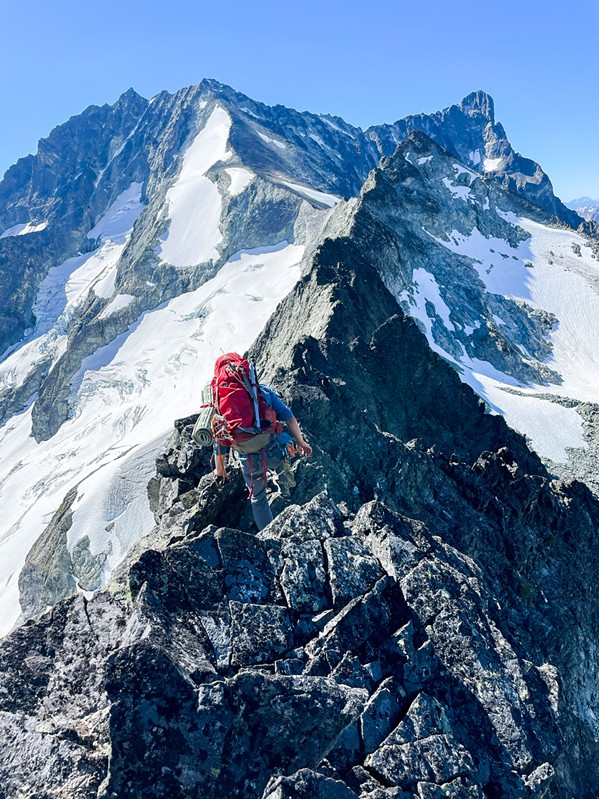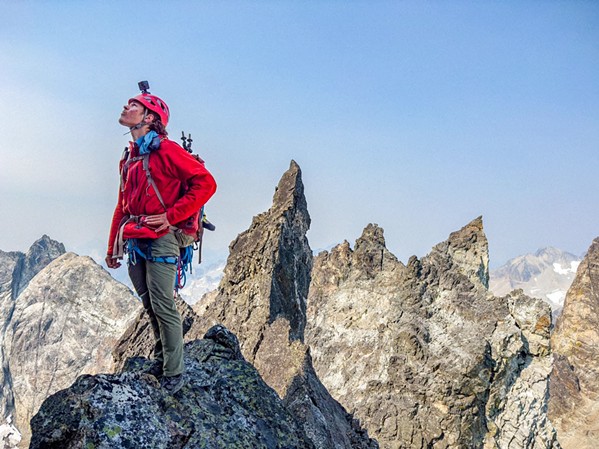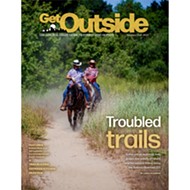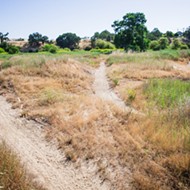FEATURE: Cal Poly computer science major Andrew Okerlund is the youngest and second fastest climber to complete The Bulger List of Washington State’s 100 highest peaks in a single season
By Glen Starkey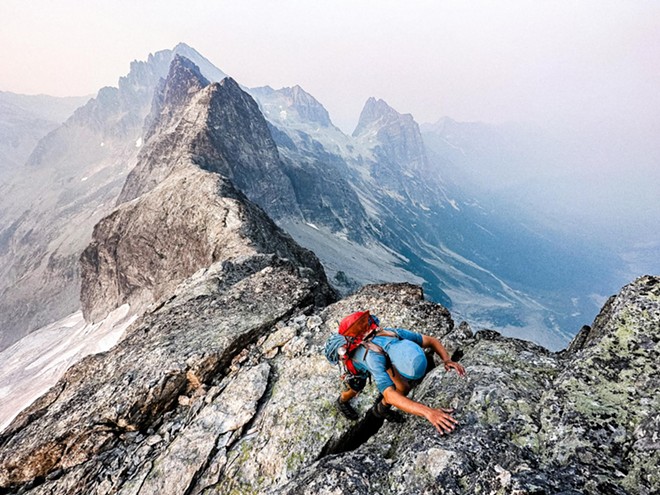
COURTESY PHOTO BY ROSS JAMES WALLETTE
HANG ON Andrew Okerlund scrambles up East Mox, one of the peaks on The Bulger List.
[
{
"name": "Newsletter Promo",
"id": "NewsletterPromo",
"class": "inlineCenter",
"insertPoint": "4",
"component": "15264767",
"requiredCountToDisplay": "0"
},
{
"name": "Ad - Medium Rectangle CC01 - 300x250 - Inline Content",
"class": "inlineCenter",
"insertPoint": "8",
"component": "15582119",
"requiredCountToDisplay": "12"
},{
"name": "Ad - Medium Rectangle LC01 - 300x250 - Inline Content",
"class": "inlineCenter",
"insertPoint": "18",
"component": "15582122",
"requiredCountToDisplay": "22"
},{
"name": "Ad - Medium Rectangle 9 - 300x250 - Inline Content",
"class": "inlineCenter",
"insertPoint": "28",
"component": "15582121",
"requiredCountToDisplay": "32"
}]
Seven hundred miles. An elevation gain of 400,000 feet. A total of 100 separate peaks. All in 85 days. From June 18 through Sept. 11, 2023, then-20-year-old Cal Poly computer science major Andrew Okerlund, now 21, took on The Bulger List, Washington State’s 100 highest peaks, becoming the youngest and second fastest climber to achieve the feat. He’s only the fifth climber ever to complete the list in a single season.
Okerland scrambled up volcanos, traversed glaciers, and disappeared into the wild for weeks at time, carrying everything he needed to survive.
“The Cascade Mountains in Washington are an extremely amazing place,” Okerlund said. “They feel extremely remote. I would be out there and not see anybody else, just me and my climbing partner. It does feel like you’re the first person to ever be in these places. There’s just extreme beauty, and the mountains themselves are extreme—they rise out of 2,000-foot-deep valleys to 6,000 feet of gain to these very glaciated and jagged-looking peaks. I’m in love with the Cascades.”
Okerlund grew up in Camas, Washington, about 20 minutes north of Portland, where he went camping and backpacking with his family.
“I don’t think I was particularly reckless as a child. Maybe I liked to climb on the playground a little bit higher than the other kids.”
It wasn’t until high school that he became obsessed with climbing.
“When I could drive, that’s when my friends and I started to get into exploring a bit more and going on our own backpacking trips.”
He started by climbing peaks in his vicinity, but he soon discovered, “This is a thing people do, and there are actually routes and there’s complexity to it. Different mountains are harder than other mountains. After that, it got a little more selective.”
He and his friends began taking on more challenging peaks, ones that were renowned for their difficulty.
“The summer after my freshman year in college, there were these five volcanos in Washington, which all kind of varied in difficulty, and I wanted to climb the easiest one, Mount Adams, with my friends, so we climbed that, and then I was like, ‘Oh, well, maybe I can climb all five of them that summer.’ They got progressively harder: Mount Baker was the next one we climbed, and that one is glaciated, so there are crevasse risks, and you need to have a rope, so we learned some skills. I climbed that one and I was like, ‘OK, now we’re going to climb Rainier,’ which is kind of like the big, bad one that people die on.
“It’s a really big mountain, big weather patterns, and really big glaciers. So we did that,” he continued. “This was my second summer of general mountaineering in Washington, and I read about these two guys—Jason Hardraff and Nathan Longhurst—who had done The Bulger List in a single season, and it was the first time it had ever been done in a single season. People had only done it over the course of many years.”
He began planning his Bulger List trip for the following summer, but he knew over the next nine months, he needed to gain more skills.
“I didn’t have the technical knowhow to do a lot of the peaks because they required technical rock climbing and route-finding skills, and just efficiency with rope work so you’re fast and safe. That’s what I lacked.”
When he returned to Cal Poly for his sophomore year, he found a mentor in mechanical engineering student and climber Nicole Morgan.
“When I got to SLO, the first thing I did was find someone who could teach me, mentor me, in this form of rock climbing. A lot of people around here rock climb, but they don’t do the kind of climbing that’s applicable to mountaineering, which is called trad climbing. It has this specialty of gear and an increase level of knowledge you have to have, and it’s just more dangerous.”
Soon he was taking climbing trips to Joshua Tree and Utah, Nevada, different places in California to practice his skills.
“I was practicing rock climbing and then simultaneously trying to work on my conditioning, so I was doing hella repeats with the pack on and running a lot and trying to fit all that in between my [Cal Poly] course load.”
When the season approached in 2023, he felt like he was ready: “I spent the whole nine months between September and June planning for it, so I had a whole itinerary and calendar marked up.”
His first summit, however, didn’t go as he hoped.
“The first trip I felt some hesitation, which was a combination of being a little naive about what I was I was getting into, and then bad weather. It was snowing and raining and cold, and [I had] bad footwear and got blisters. It was a high mileage trip—I was shaking all the problems out of the way, I guess. That first trip, I was soaking wet, and it was midnight and I still had seven hours to go, and I thought, “I hope it’s not all like this.’”
Things went more smoothly after that, and the longest stretch he took off without climbing was three days.
“I didn’t like taking that much time off. I was dying to go out, but it was for the better ultimately.”
Safety was always a concern, which is why he didn’t climb alone.
“I have a satellite device, but you sort of assume, whatever goes wrong, you have to rescue yourself. Generally speaking, in the Cascades, there is a rescue option, but it’s a matter of how long it’s going to take them to get there, and it may take them a very long time. You are assuming risk, but your first line of defense is not making mistakes in the first place.”
That mostly worked out, but Okerlund recalled one instance when he and his climbing partner got off-route traversing between two peaks. Desperate to avoid having to backtrack, he took a risk.
“I decided to just down-climb a section, like, OK, we’ll just go down this side, you know, kind of blind, but it looks like it will work, but we don’t actually know.”
Things got dicey.
“It’s kind of like being in the middle of this [rock] face, and you’re feeling very trapped, like you don’t want to go down, you know going up isn’t going to lead anywhere, so you’re in this state of bouncing back and forth between what you have to do. Eventually I figured out that I could go up and left and then down and rappel off a tree, but for a moment there it felt very insecure.”
Okerlund funded his trip through his own savings, crowdfunding from relatives, and he got help from Zach Hein, founder of Range Meal Bars, who supplied some food and videographer Ross James Wallette, who chronicled Okerlund’s achievement in the YouTube documentary 100 Summits, Bulgers in a Season, released on June 14.
Now that he’s the youngest and second fastest, does Okerlund want to be the fastest?
“No, I don’t need to be the fastest,” he laughed. “In fact, I probably wouldn’t climb all 100 peaks again. I would do a different 100. When I was going through it, I knew it was possible because other people had done it, so the next thing I’d be looking to do it something that hasn’t been done, so you have no idea if it is possible.”

